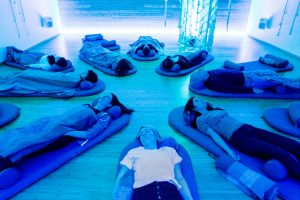How to Get a Good Night’s Sleep
I’m exhausted. Aren’t you? For an article about how Silicon Valley and other innovators have taken on the challenge of sleeplessness, a $32 billion market once populated mostly by mattress and pharmaceutical companies, I tested but a few of the many hundreds of gadgets, apps, podcasts and other inventions now devoted to a good night’s sleep. As the gizmos grow more elaborate, imbued by ever more exotic technologies, they are creating a ruckus in our bedrooms, and sleep experts advocate a simpler approach. Here are a few of their tips (and a gizmo or two):
“Sleep With Me,” a wildly popular podcast by Drew Ackerman, a gravelly voiced librarian who tells excruciatingly boring bedtime stories, has millions of fans, but it makes me anxious. At M.I.T.’s Media Lab, the researcher David Rose and his colleagues stumbled upon recordings of Icelandic folk tales, which they found incomprehensible, of course, and therefore more soothing and soporific.
Arianna Huffington, author of “The Sleep Revolution: Transforming Your Life, One Night at a Time,” suggests following the bedtime rituals we gave our children. “You didn’t just throw your baby in bed,” she said. “There was a transition. A hot bath makes it easier for you to wash away the day.”
A no-brainer. If you must have a gizmo in there with you, the Sense pod, a delicate polycarbonate sphere, measures temperature, air quality, humidity and other intangibles.
Mr. Rose and his colleagues are investigating what makes an ideal sleep environment. To evoke the feeling of many blankets on a cold night, Mr. Rose turned to the weighted blankets used as sensory therapy for autistic children.
Thank your body parts, starting with your feet. Nancy Rothstein, director of Circadian Corporate Sleep programs and otherwise known as the Sleep Ambassador, teaches a relaxation recipe that mixes gratitude with body awareness and deep breathing. As in: “Feet, I’m so grateful for all you did today. You carried us everywhere we had to go. You can rest now.”
If you’re tracking your sleep on your phone, wait until morning to check your stats.
Or do as Mr. Rose at M.I.T. does. Mr. Rose lives with a collection of interactive furniture and animated objects, like Alexa by Amazon and Personal Assistant by Google and Aura, a sleep tracker and alarm clock by Withings that looks like a ship’s funnel and uses light to regulate melatonin. He and his family sometimes struggle with the beguilements of his enchanted objects, as he calls his gizmos. His children play Alexa and Google’s Personal Assistant off each other, a battle of the robots. And when he reads Harry Potter to his son at night, Alexa has taken to playing the theme song from the movies.
Recently, however, Mr. Rose invited a new gizmo into his apartment to police the other devices. Called “Circle,” it wirelessly scouts all the technologies in the house — his children’s iPads, internet-connected guitars, toys and his own phone — and sets rules for their use, which is to say, it sets bedtime for the robots, so everyone can get to sleep.
Original article: https://www.nytimes.com/by/penelope-green




